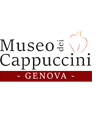Capuchin Cultural Heritage Museum
In the city centre, attached to the church of SS. Annunziata di Portoria where the Mausoleum of Santa Caterina Fieschi Adorno can be found, is the Capuchin Cultural Heritage Museum collects which the rich artistic heritage of the Ligurian monasteries.
Inside there are not only works by the most famous Genoese painters of the sixteenth and seventeenth centuries, among whom Luca Cambiaso, Bernardo Strozzi, Orazio De Ferrari and Domenico Piola stand out, but also precious sacred furnishings and objects of craftsmanship and Capuchin “arte povera” such as frontals, wooden sculptures, nativity scenes as well as silverware of undisputed artistic value.
The visit to the Capuchin museum and to the monumental complex of the church of the Annunziata di Portoria offers the visitor a glimpse of the city's history, telling the story of the Portoria district and its great hospital in Pammatone where Santa Caterina da Genova offered assistance to victims of the plague, but it is here represented through the work and mission of the Capuchin friars, who for about five centuries have been at the service of the population with their religious witness and assistance to the needy.
The museum offers exhibition events with interesting insights consistent with the mission of the museum and the Capuchin friars themselves.
Top Ten
The works in the museum testify to the presence in the region, to the spirituality and the austerity that has always characterized the Franciscan Order and in particular that of the Order of Friars Minor Capuchin.
There are ten works that are particularly significant to the museum's heritage and that the visitor can always find during a visit regardless of any temporary installations. They come from the convents of the Ligurian Capuchins and are not only valuable works of art, such as the Polyptych of San Barnaba or the valuable monochrome painting dedicated to San Felice da Cantalice by Bernardo Strozzi, called the Capuchin because he belonged to the order, but also works of craftsmanship, produced over the centuries by the hands of skilled friars carvers, weavers, sculptors, etc.
A truly unique work is a two-faced sculpture in marble carved on both sides, depicting Saint Anthony of Padua with Jesus on one side and on the other the saint with the Virgin and Child.






Follow us on Facebook
Follow us on Tripadvisor
Follow us on Instagram
Follow us on Twitter